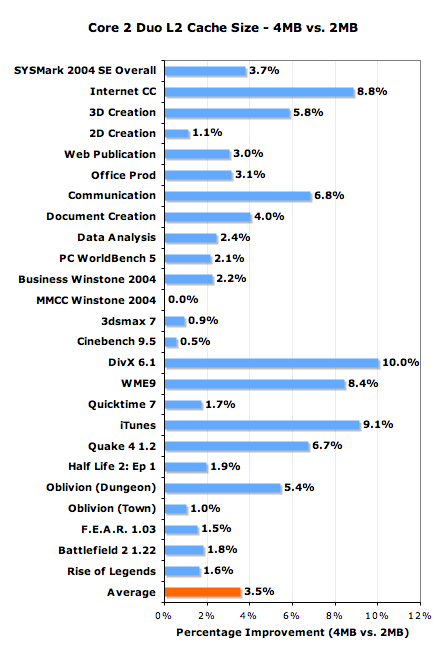Intel's Core 2 Extreme & Core 2 Duo: The Empire Strikes Back
by Anand Lal Shimpi on July 14, 2006 12:00 AM EST- Posted in
- CPUs
L2 Cache: 4MB or 2MB?
The majority of Intel's Core 2 Duo line feature a single shared 4MB L2 cache, but the E6300 and E6400 are only equipped with a 2MB cache. Given that the Core 2 Duo doesn't have an on-die memory controller, it is more dependent on larger caches than AMD's Athlon 64 X2, which raises the question - how big of a difference is there between the 2MB L2 and 4MB L2 parts?
Our Core 2 Extreme X6800 (2.93GHz) part, like all X6800s, is unlocked so we could simulate any other Core 2 Duo clock speed with it. We managed to get our hands on a Core 2 Duo E6300 (1.86GHz/2MB) and we were in business.
The graph below features all of the benchmarks we ran on the processors in this review, showing the percent performance improvement from a Core 2 Duo E6300 (1.86GHz/2MB) to a hypothetical 1.86GHz Core 2 Duo with a 4MB L2 cache. The bar labeled "Average" is simply an average of all of the performance improvements graphed on the chart.

The 4MB L2 cache can increase performance by as much as 10% in some situations. Such a performance improvement is definitely tangible, and as applications grow larger in their working data sets then the advantage of a larger cache will only become more visible. Unfortunately, you do pay a price premium for this added performance and future proofing as the cheapest 4MB L2 part is the E6600 priced at $316.
If you're the type to upgrade often, then the extra cache is not worth it as you're not getting enough of a present day increase in performance to justify the added cost. However, if this processor will be the basis for your system for the next several years, we'd strongly recommend picking a 4MB flavor of Core 2.










202 Comments
View All Comments
Kougar - Friday, July 14, 2006 - link
I wasn't sure of the B2 Stepping 6 info because it has been impossible to find CPU-Z shots of this chip, let alone anyone reviewing them!!Mostly I just want to ensure Intel doesn't pull any surprises or OC limiting with them, at this point if the B2 Stepping 6 with that last round of bugfixing performs even the same as a Stepping 5 I'd be extremely happy!
redpriest_ - Friday, July 14, 2006 - link
Thanks Wesley - my Core 2 Duo Extreme X6800 is definitely a Stepping 6, Revision B2 Conroe. It has a packaging date of July 5, 2006. I have all the multipliers unlocked, and I am stuck at around 3.466 ghz using multipliers only for stability. I am running on the Intel 975X BadAxe rev 304 with the latest BIOS.I haven't tried upping the bus from there, yet - I am using 1.4 volts; default voltage isn't dual prime 95 stable at 3.466 ghz, but is at 3.2 ghz.
I haven't tried any intermediate voltages between there to test, so it's possible my Conroe is stable at 3.466 ghz at less voltage. I'll give that a try.
Kougar - Friday, July 14, 2006 - link
What motherboard is this? Have you double-checked your RAM settings and memory ratio? I'd imagine setting a 1:1 ratio, using the most relaxed timings, and slowly ramping up the FSB would get you further. And do try less voltages... ;)That's my plan anyway, DDR2-800 memory speeds on a 1:1 ratio thanks to a 400FSB, 10x multiplier... :)
Kougar - Friday, July 14, 2006 - link
Anandtech used Engineering Sample CPUs, so they would be B0 Stepping 4 or B1 Stepping 5 only. Only retail models will be B2 stepping 6...Did you change your cpu voltage any? Sounds like you didn't ;)
redpriest_ - Friday, July 14, 2006 - link
I had to - 1.4 (1.35 real) to get to 3.466, and 1.5 to 3.733.Wesley Fink - Friday, July 14, 2006 - link
Did you OC by adjusting multipliers first? We could run the X6800 at 3.46 at 13 multiplier using stock voltage, but using 315 bus times the stock 11 multiplier required a small voltage increase. The easiest OCs used higher multipliers and modest FSB increases. The E Conroes are locked, however, and can only be overclocked by increasing the FSB.redpriest_ - Friday, July 14, 2006 - link
Yes, I tried using multipliers only, I haven't fiddled with bus speed yet.Kougar - Friday, July 14, 2006 - link
First, the X6800 is selling at NewEgg, and they are price gouging it for all it's worth. Still listed in stock after having been up for 3+ hours...What a great way to start the day... Thank you Anandtech for this great article! Supurb! Now I have to agree with the poster above me, some info on the E6300 overclocking would about round out my curiosity!
I have a question though, do y'all or anyone else have some CPUZ shots of a retail shipping Conroe? I believe this are supposed to be revision B2 stepping 6??
As for the expected skeptics, my saying the numbers appear to jive won't mean anything... so I'll just say there are over 25 reviews out now of the Core 2 Duo released today. :)
mAdMaLuDaWg - Friday, July 14, 2006 - link
I'm curious on if you tried OCing the E6300. What was the highest stable speed you were able to get.xsilver - Monday, July 17, 2006 - link
for those who dont want to read the xbit labs articlethe overclocking of the e6300 is limited by the motherboard - eg. cant get the board to boot at any higher than 420mhz fsb
we may have to wait for nvidia's core2 solution to see higher fsb's